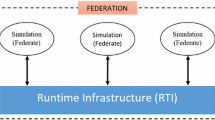Abstract
UAV research generally follows a path from computer simulation and lab tests of individual components to full integrated testing in the field. Since realistic environments are difficult to simulate, its hard to predict how control algorithms will react to real world conditions such as varied lighting, weather, and obstacles like trees and wires. This paper introduces a methodic approach to developing UAV missions. A scaled down urban environment provides a facility to perform testing and evaluation (T&E) on control algorithms before flight. A UAV platform and test site allow the tuned control algorithms to be verified and validated (V&V) in real world flights. The resulting design methodology reduces risk in the development of UAV missions.
Similar content being viewed by others
References
Alwan, M., Wagner, M.B., Wasson, G., Sheth, P.: Characterization of infrared range-finder PBS-03JN for 2-D mapping. In: International Conference of Robotics and Automation (ICRA) (2005)
Ye, C., Borenstein, J.: Characterization of a 2-D laser scanner for mobile robot obstacle negotiation. In: International Conference of Robotics and Automation (ICRA) (2002)
Orr, M.W., Rasmussen, S.J., Karni, E.D., Blake, W.B.: Framework for developing and evaluating MAV control algorithms in a realistic urban setting. In: American Control Conference (ACC), pp. 4096–4101 (2005)
Netter, T., Franceschini, N.: A robotic aircraft that follows terrain using a neuromorphic eye. In: International Conference on Intelligent Robots and Systems (IROS), pp. 129–134 (2002)
Narli, V., Oh, P.: A hardware-in-the-loop test rig for designing near-earth aerial robotics. In: International Conference on Robotics and Automation (ICRA), pp. 2509–2514 (2006)
Allerton, D.J.: Flight simulation: past, present and future. The Aeronaut. J. 104(1042), 651–663, December (2000)
Scherer, S., Singh, S., Chamberlain, L., Saripalli, S.: Flying fast and low among obstacles. In: International Conference on Robotics and Automation (ICRA), pp. 2023–2029 (2007)
Hsieh, M.A., Cowley, A., Keller, J.F., Chaimowicz, L., Grocholsky, B., Kumar, V., Taylor, C.J., Endo, Y., Arkin, R.C., Jung, B., Wolf, D.F., Sukhatme, G.S., MacKenzie, D.C.: Adaptive teams of autonomous aerial and ground robots for situational awareness. J Field Robot 24(11–12), 991–1014, November (2007)
Author information
Authors and Affiliations
Corresponding author
Additional information
This work is funded in part by the National Science Foundation CAREER award IIS 0347430.
Rights and permissions
About this article
Cite this article
Sevcik, K., Oh, P. Testing Unmanned Aerial Vehicle Missions in a Scaled Environment . J Intell Robot Syst 54, 297–305 (2009). https://doi.org/10.1007/s10846-008-9267-9
Received:
Accepted:
Published:
Issue Date:
DOI: https://doi.org/10.1007/s10846-008-9267-9




